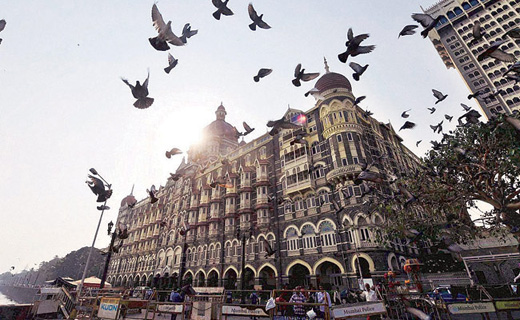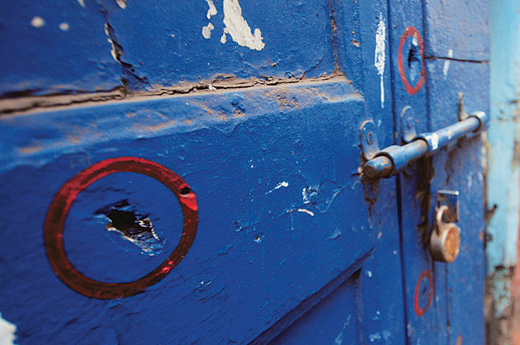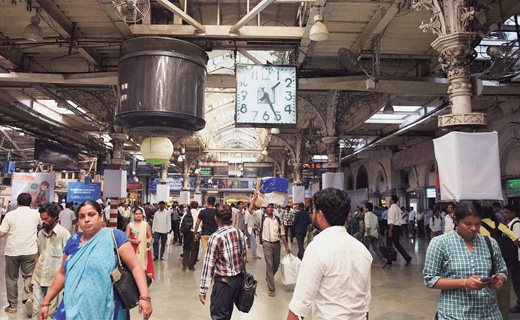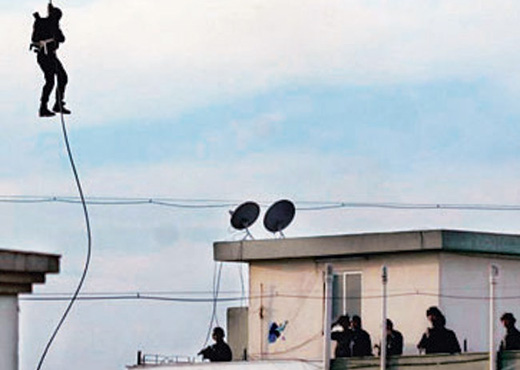Six years on, Mumbai still bears the scars of 26/11 attacks
mangaloretoday.com/ India Today

The gruesome scars of the attack are still visible.
At all the sites in Mumbai targeted by terrorists on November 26, 2008, the gruesome scars of that attack are no longer visible, except at the Nariman House which housed the Jewish Chabad. It is the only site in Mumbai which has preserved the marks of devastation inflicted by two of the 10 terrorists who had attacked the Jewish Chabad and killed a rabbi and his wife. At the other sites-Taj Hotel, Trident, Leopold Cafe, Chhatrapati Shivaji Terminus (railway station) and Cama Hospital-have been given a makeover to remove the physical scars left behind the terrorists.

Nariman House
When Nariman House was opened again on August 26 this year, the Jewish community vowed that it would preserve the top two floors as a museum. Dedicated to the memory of slain rabbi Gabi and his wife Rivky Holtzberg, Nariman House now has enhanced security features-including reinforced steel doors, electronic access and surveillance cameras.
Though the restoration work in the lower floors is almost complete, the Chabad is still not fully operational. "There are prayer services sometimes and some activities of the Jewish community," said a Jewish follower who supports the Chabad.

The Chabad House is the only place where the scars of that audacious terror attack have been preserved.The Chabad-Lubavitch of Mumbai offers Jewish education, outreach and social service programmes for families and individuals of all ages, backgrounds and affiliations. The work for converting the top two floors into a museum has not yet begun.
The Chabad would also be the only place in Mumbai to house a memorial for all the 26/11 victims. The memorial on the terrace of Nariman House would be in the shape of a prism with the names of all those who were killed during the terror attack.
Surveillance & Safety
On 26 November, 2008, the terrorists had gone from Backbay in South Mumbai to different locations undetected by the police. Following the attack, an ambitious plan to cover Mumbai under a network of high resolution surveillance cameras was mooted. However, the project remained only on paper due to lack of political in the previous Congress-NCP government. But now, Chief Minister Devendra Fadnavis, who also holds the home portfolio, has expedited the process to install 5,000 CCTV cameras at key points in Mumbai. As the last hurdles in the project have been cleared, the work on the installation of cameras would start soon.
Coastal Security
Passengers make their way through Chhatrapati Shivaji Terminal on the eve of 26/11’s sixth anniversary.The 124-km coastline of Mumbai continues to be most vulnerable despite the presence of several forces, including the Indian Navy, Coast Guard and Marine Police. The previous state government had purchased boats, and had got together some officers and policemen and called it Marine Police. The policemen undergo one-month training with the Coast Guard that includes only one week on the seas. But the reality is quite bleak. No one wants to join the Marine Police and only those who do not wield enough influence to cancel their transfer orders join the force. There have been several instances in the past where the Marine Police personnel have been rescued by the Coast Guard.

Countering Terror
An NSG commando rappels to the roof of Nariman House during the attack.The delay in the arrival of the National Security Guard (NSG) commandos in Mumbai during the three-day siege gave terrorists more time to unleash mayhem. Under severe criticism, the then Congress-led government at the Centre announced a hub in Mumbai for the elite commandos.
The NSG reluctantly moved into the 23-acre plot at Marol in Mumbai which they deemed unsuitable for their requirements. The commandos are forced to carry out counter-terror drills during night time to avoid exposing their tactical secrets to the curious residents in nearby highrises. Not wanting to be dependent on outside help in case of a terror attack, Maharashtra Police set up its own commando unit-Force One. Police officials claimed that Force One has evolved into a robust unit to counter terrorist attacks and could respond to emergencies in 15 minutes.
- Nethravati bridge work hits traffic movement between Pumpwell and Thokkottu on NH 66
- Five villages in Karnataka to be developed as Climate Resilient Coastal Fishermen Villages: Union Minister
- Bajpe: Thieves break into house; decamp with jewellery worth Rs 80 lakhs
- Blessings of the renovated chapel at Queen of Apostles Convent at Vamanjoor
- Mangaluru: Network issue due to jammers at district prison; technicians conduct inspection
- Mangaluru: Speeding bike fatally knocks down pedestrian on Airport road
- Suratkal Inspector, SI and 2 others chosen for CM’s Medal
- Chikkamagaluru: Man kills 3 family members, self in Khandhya hobli
- Diesel price up by Rs 2 per litre after Karnataka hikes sales tax rate
- ‘Government has deliberately closed issuance of BPL cards for two years’
- BJP to hold ‘Janakrosha Yatra’ in Dakshina Kannada on April 9
- Changes in train services to facilitate track maintenance works in the Palakkad division
- India to witness hotter than usual temperatures from April to June: IMD
- President Trump announces 27% reciprocal tariff on India
- Indian Navy seizes 2,500 kg narcotics in Western Indian Ocean
- Two women Naxalites killed in encounter in Madhya Pradesh’s Mandla district
- Days after mega delimitation huddle, MK Stalin’s letter to PM Modi
- Pak Army crosses Line of Control, opens fire, India retaliates: Army sources
- High Court stays FIR against Yatnal on his remarks against Ranya Rao
- Internet cafe sealed for downloading, distributing pirated version of ’Empuraan’
- Congress running Tughlaq durbar in Karnataka: B S Yediyurappa
- Highway travel to get more expensive: Toll charges hiked by 4-5% across India
- Bengaluru teacher arrested for extortion after affair with student’s father
- Karnataka BJP to hold series of protests against state govt from April 2
- 1993 Mumbai blasts: Mumbai Court orders release of Tiger Memon’s 14 properties to centre
- Skills and Competencies Take Center Stage at MSN Dialogue Series
- Court remands Maoist Lakshmi to six-day police custody
- Sandhya Shenoy honored with Society for Materials Chemistry Medal-2024
- White Cornus Apartment in Mangaluru
- City girl wins first place in state-level spell bee competition
- Alleged ‘Love Jihad’ Case in Mangaluru: Woman left home voluntarily, says police
- Girl fatally struck by reckless two-wheeler near Belman
- New residential complex for the judges inaugurated in Mangaluru
- Absconding accused nabbed after 8 years
- Truck with cylinders turns turtle in Beltangady
- Bhoota Kola artist dies of cardiac arrest
- Development of the country should be our goal: Ganesh Karnik
- Container truck gets stuck under Modankap railway bridge
- Truck crushes bike’s pillion rider near BC Road
- Head constable dies of heart attack
- CITY INFORMATION
- TRAVEL
- TOURIST INFORMATION
- HEALTH CARE
- MISCELLANEOUS




 Write Comment
Write Comment E-Mail To a Friend
E-Mail To a Friend Facebook
Facebook Twitter
Twitter  Print
Print 


